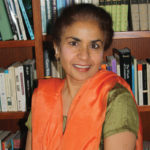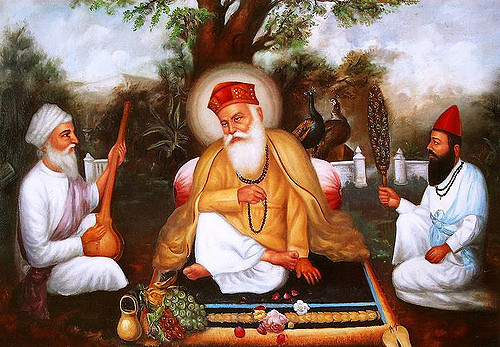“Guru Nanak offers us a strong and enduring infrastructure with fellow beings. We remember him, we imagine him,

and we praise him for breaking barriers; innovatively and gently he guides us to envision the single Reality – timeless, formless, fearless, who cannot and must not be confined to any sect or religion. Men and women of all ages, stages of life, sexual orientations, and religious backgrounds are inspired by his “magical” personality and “magical” words. They are magical for sure, precisely because they are so real, applicable, and empowering. The Guru Nanak Effect surges across multifarious channels and moves us to embrace fellow beings. Seeing our self in the other is what Guru Nanak’s spiritual, philosophical, and musical renditions bring about.”
Guru Nanak’s 974 hymns recorded in the Guru Granth Sahib are an extraordinary philosophical gift for humanity. In his spiritual lyrics our magical shair-dhadhi conjoins verbal language and musical sound. Each simple brief passage is so richly packed that it can be utilized to navigate any aspect of life at any stage. Guru Nanak’s timeless verse infiltrates precise historical moments and emotions to generate new values, new attitudes, new orientations, new social and cosmic relationships.
Guru Nanak’s philosophy is grounded in his ontological experience of Reality—that of the One infinite reality, Ikk Oan Kar. Whether it is Being, Knowledge, Beauty, Morality, or Liberation, the philosopher Nanak approaches these perennial issues as a poet. The word “method” is a composite of meta (after) and hodos (way) and in Guru Nanak’s method, philosophy and poetry are not at odds with each other. Plato may have found poetry too captivating and therefore banished the poets from his Republic, but the divinely inspired Guru tried to awaken his followers and revitalize their senses, psyche, imagination, and spirit through poetry. Across his oeuvre the Guru’s intimate experience of the infinite One is fused with his keen philosophic pursuit towards an ever-widening Reality. As he interrogates, analyzes, criticizes, and wonders, he perfectly illustrates Wittgenstein’s maxim that philosophy ought really to be written as one “writes a poem.”
In fact Guru Nanak identifies himself as a “poet” (shair): “my breath, my flesh, my very life is Yours, You are my absolute love, and this is what poet (sairu) Nanak says, You are our true provider—sasu masu sabh jio tumhara tu mai khara piara, nanaku sairu ev kahatu hai sache parvadgara” (GGS: 660). He also calls himself a “songster” (dhadhi): “a dhadhi of low caste—hau dhadhi ka nic jati (Asa di Var, 9). These self-references introduce us to a most humble personality; the living breathing corporeal figure is before our eyes, with each pore saturated in the Divine. He is the picture-perfect image of his supreme moral value “sweet humility, Nanak, is the core of virtues and good deeds” (GGS: 470).
Guru Nanak’s 974 hymns recorded in the Guru Granth Sahib are an extraordinary philosophical gift for humanity. In his spiritual lyrics our magical shair-dhadhi conjoins verbal language and musical sound. Poetry is universal to begin with, and set in musical measures enhances their access to audiences who may not know the language. Cosmic melodies, sounds of nature, musical instruments, and biological rhythms reverberate across Guru Nanak’s mesmerizing repertoire. Completely taken by his awareness and love for the universal Divine the Guru has no control over his words: “jaisi mai ave khasam ki bani taisara kari gianu ve lalo—as comes to me the Husband’s word, that is what I say O’ Lalo!” (GGS: 722).
Paradoxically, his spontaneous speech ends up being most philosophically meaningful and aesthetically effective. His melodious ensemble is full of vibrant spiritual, emotional, social, and political resonances. Each simple brief passage is so richly packed that it can be utilized to navigate any aspect of life at any stage. Guru Nanak’s timeless verse infiltrates precise historical moments and emotions to generate new values, new attitudes, new orientations, new social and cosmic relationships. The Guru has gifted us an inexhaustible reservoir that diverse cultures can keep feeding on for generations. For instance we can draw upon the following Nanakian metapahysical, ethical, and artistic values:
- For our dangerously divided and polarized world, what could be more valuable that Guru Nanak’s philosophical vision of Ikk Oan Kar – One Being Is? The primary number ‘1’ is immediately recognizable to people of all languages and cultures. The transcendent Divine is without any borders — linguistic, spatial, temporal or gender. The singularity and unity of the Divine is reproduced over and over in his hymns. We need to get a real feel for the oneness because without it we cannot implement our social, political, economic, and environmental policies. How do we bring about change in our global world today? Only when we align ourselves with That One will we take constructive steps towards equality, healthcare, education, and ecosystem.
Moreover Guru Nanak’s philosophy is life affirming. This world is sacred because the divine One is everywhere. Human life is precious “like a diamond” (hire jaisa). Therefore we must ethically live out our diamond like qualities. We exist authentically by attending to ourselves, to our family members, to our communities, and to the world at large. The temporal world is a part of the Infinite One and partakes of its characteristics. The deeper our awareness of the Divine, the more vibrant is our participation in the everyday affairs. We are grounded in our social context. Guru Nanak’s ideal fits in perfectly with our secular lifestyles, for we do not need to give up our families, professions, or hobbies. Our human obligation is to refine our mental, emotional and spiritual faculties so that we construct a better world for all of us, and for our future generations. All of us are equally responsible.
2) Guru Nanak’s artistic language is full of love. Without “teaching” as such, his beautiful lyrics train us to appreciate and absorb this healthy and wholesome emotion. His words go beyond discords of Sanskrit and Arabic, polytheistic and monotheistic, eastern and western, ancient and modern, classical and vernacular, human and cosmic. When we familiarize ourselves with Allah, Khuda, Nirvana, Banvari, Hari… we sweat out toxic hostilities and begin to feel the different features of our shared humanity. Different images and symbols from respective religious and cultural backgrounds come together harmoniously in his calligraphy of love. How could there be communal bloodshed when we share our universal language? Since the infinite source is the Beloved — piara — whatever ensues and however it ensues, has to be love. Multi religions and multi cultures and multi languages sonorously play in Guru Nanak’s philosophical poetry.
3) Guru Nanak charges everyone—equally to make this world a better place for all of us. He rejected the customary four-fold division of Indian society into Brahmins, Kshatriyas, Vaishyas, and Shudras, along with its division of life stages brahmacarin, grahastha, vanaprastha, and sanyasin (varna-ashrama-dharma). Diametrically opposed to the fourfold societal hierarchy and its corresponding privileges, duties, and responsibilities, he postulates the same morality for people of all classes, races, faiths, and ages. The Guru categorically says that there is only one Dharam: “eko dharam” (GG: 1188). The mutually exclusive scripts that were enforced on people simply on the basis of their biological birth are obliterated. Everyone is equally impelled to perform their ethical duty throughout their entire life. The Kshatriya is not obligated to take up arms for justice, nor the White Man to carry out his burden. Hearing, singing, reciting, and experiencing his verses free us from the conventional codes that smother self-worth and self-realization, and motivate each one of us to actualize our human potential. His philosophical poetics offers a compelling critique of the ancient caste system, untouchability, religious divisions, and basic human degradation. We are inspired to fight against patriarchal “isms” of classism, ethnocentrism, racism, and sexism that continue to fester our modern society.
4) He offers an exciting bridge between religious studies and natural sciences, which remain divided in our contemporary society. Recurring verses fill us with curiosity about our cosmos and the myriad species: “vismad dharti vismad khani – wonderful earth! Wonderful species!” (GGS: 464) The Guru ushers us into a magical space where we become epistemologically open-minded and discover new tracks. Similarly, “patala patal lakh agasa — worlds below worlds millions of spheres beyond spheres” (Japji: 22) shifts our attention from a geocentric model of the universe to the ultramodern view of “multiverse” (multi as distinct from universe). It is as though the Guru were offering us a sneak preview of the highly sophisticated technological view from the New James Webb Space Telescope! The knowledge of infinity destroys all kinds of limitations and prejudices, and creates an all-accepting and welcoming attitude. Guru Nanak’s verse is like entering a planetarium: its mystery and thrill leave us wide-eyed. Overall, Guru Nanak’s poetic repertoire verse offers a sumptuous variety of images, symbols, and metaphors that have the potential to help readers realize the countless resources of our common humanity. The literary devices integrate the intellectual faculties with the aesthetic, axiological, and emotional self. Absorbing them fosters morality. For our shair-dhadhi an aesthetic experience of the ambrosial poetry was the only avenue to real change. It would make the inner circuits and impact external conduct. The aesthetic experience is neither antithetical to the metaphysical doctrine of Oneness, nor antithetical to moral behavior; rather, it is the mechanism for ethical and spiritual growth.
In the 21st century how easily we connect over Email, Twitter, Skype, WhatsApp, Facebook, Instagram… But do we connect emotionally and spiritually? Guru Nanak offers us a strong and enduring infrastructure with fellow beings. We remember him, we imagine him, and we praise him for breaking barriers; innovatively and gently he guides us to envision the single Reality – timeless, formless, fearless, who cannot and must not be confined to any sect or religion. Men and women of all ages, stages of life, sexual orientations, and religious backgrounds are inspired by his “magical” personality and “magical” words. They are magical for sure, precisely because they are so real, applicable, and empowering. The Guru Nanak Effect surges across multifarious channels and moves us to embrace fellow beings. Seeing our self in the other is what Guru Nanak’s spiritual, philosophical, and musical renditions bring about. The founder Guru’s 551st birth anniversary is but the beginning of exciting new encounters….
Gurpurab Mubarak!
(Author of scores of books, Professor Nikky-Guninder Kaur Singh is Chair of the Department & Crawford Family Professor of Religion, Colby College, Waterville, ME. USA.)
